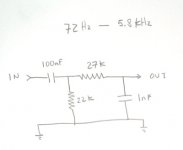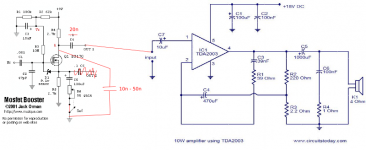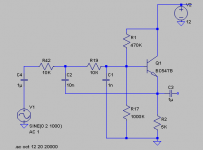Hi Guys,
I have been doing some practice guitar amps, I have tested lm386, tda2822n, and a lot of ther TDAs... In the frontend I have tested OpAmps, JFETS, and BJS.....
Finally, I like the TDA2003 + MOSFET Booster (AMZ) but the sound at high volume is too harsh. So I want to do some frequency filtering to archive some kind of speaker simulation because my speakers are Full-Range.
I have been reading about the ROG Condor Cab Sim and many others, but all of them uses active filters with OpAmps. I don't want to mimic any specific Amp nor Cabinet, I just want to mold the frequency response to roll off undesired ranges.... It doesn't have to be perfect, just good enough.
I also want to keep the circuit as simple as possible, better if no OpAmps are involved, and even better if the filters are just passive.
Any suggestions are appreciated. Or if this is impossible, please tell me why and I will abandon the idea immediately and will not waste more time on this.
Thanks for your time Guys.
I have been doing some practice guitar amps, I have tested lm386, tda2822n, and a lot of ther TDAs... In the frontend I have tested OpAmps, JFETS, and BJS.....
Finally, I like the TDA2003 + MOSFET Booster (AMZ) but the sound at high volume is too harsh. So I want to do some frequency filtering to archive some kind of speaker simulation because my speakers are Full-Range.
I have been reading about the ROG Condor Cab Sim and many others, but all of them uses active filters with OpAmps. I don't want to mimic any specific Amp nor Cabinet, I just want to mold the frequency response to roll off undesired ranges.... It doesn't have to be perfect, just good enough.
I also want to keep the circuit as simple as possible, better if no OpAmps are involved, and even better if the filters are just passive.
Any suggestions are appreciated. Or if this is impossible, please tell me why and I will abandon the idea immediately and will not waste more time on this.
Thanks for your time Guys.
Unfortunately I don't understand what do you want to do. A TDA2003 is a complete amplifier. And why a MOSFET? As a follower?
Unfortunately I don't understand what do you want to do. A TDA2003 is a complete amplifier. And why a MOSFET? As a follower?
My current topology is
Guitar -> Mosfet Booster -> Power Amp (TDA2003) -> Speaker
What I want is:
Guitar -> Mosfet Booster -> Speaker Sim -> Power Amp TDA2003) -> Speaker
The Mosfet booster is my input stage, it provides high input Z for the guitar and some initial gain.
Look up lowpasses of second order (Sallen-Key if active, and the unity-gain op-amp can become replaced by an emitter follower, see circuit!) and try fcorner=5Khz and Q=1.4 for a start. Have a good time!
Attachments
Last edited:
Look up lowpasses of second order (Sallen-Key if active, and the unity-gain op-amp can become replaced by an emitter follower, see circuit!) and try fcorner=5Khz and Q=1.4 for a start. Have a good time!
Thanks Grasso789, I wonder if a simple bandpass filter will work. Do you think something like this will do the job?

Well, most loudspeakers are lopasses of hi order, so the circuit given by me will be closer to Celestion sound. Most loudspeakers are hipasses for second order, yet open baffles are first-order hipasses, and most guitar amplifiers contain at least one first-order hipass of corner frequency hier than 84Hz, E, the fundamental of the guitar.
Well, most loudspeakers are lopasses of hi order, so the circuit given by me will be closer to Celestion sound. Most loudspeakers are hipasses for second order, yet open baffles are first-order hipasses, and most guitar amplifiers contain at least one first-order hipass of corner frequency hier than 84Hz, E, the fundamental of the guitar.
Thank you Grasso789, I will try your circuit. It looks good and simple.
This isn't rocket science, not even fancy filtering.
Hang a cap off MOSFET Drain to ground. 50nFd (1.2KHz against 2.7K) will be too mellow; 10nFd (5KHz against 2.7K) will not do much. Try caps in that range.
Yes, some bass-cut is needed if you are slapping your cone. Reduce AMZ's C4. 0.1uFd gives nearly full-range bass (17Hz against ~100K of the '2003). 0.02uFd (20nFd!) will lightly shave the bottom note of guitar, a common sound. Even smaller caps are useful for screamin'-lead sounds without cone-slap.
Hang a cap off MOSFET Drain to ground. 50nFd (1.2KHz against 2.7K) will be too mellow; 10nFd (5KHz against 2.7K) will not do much. Try caps in that range.
Yes, some bass-cut is needed if you are slapping your cone. Reduce AMZ's C4. 0.1uFd gives nearly full-range bass (17Hz against ~100K of the '2003). 0.02uFd (20nFd!) will lightly shave the bottom note of guitar, a common sound. Even smaller caps are useful for screamin'-lead sounds without cone-slap.
This isn't rocket science, not even fancy filtering.
Hang a cap off MOSFET Drain to ground. 50nFd (1.2KHz against 2.7K) will be too mellow; 10nFd (5KHz against 2.7K) will not do much. Try caps in that range.
Yes, some bass-cut is needed if you are slapping your cone. Reduce AMZ's C4. 0.1uFd gives nearly full-range bass (17Hz against ~100K of the '2003). 0.02uFd (20nFd!) will lightly shave the bottom note of guitar, a common sound. Even smaller caps are useful for screamin'-lead sounds without cone-slap.
Hi PRR, Thanks for the info, if it works, it is the most simple solution.

I will give it a try.
- Status
- Not open for further replies.
- Home
- Amplifiers
- Chip Amps
- Passive Speaker Simulator for MOSFET + TDA2003 Amplifier
